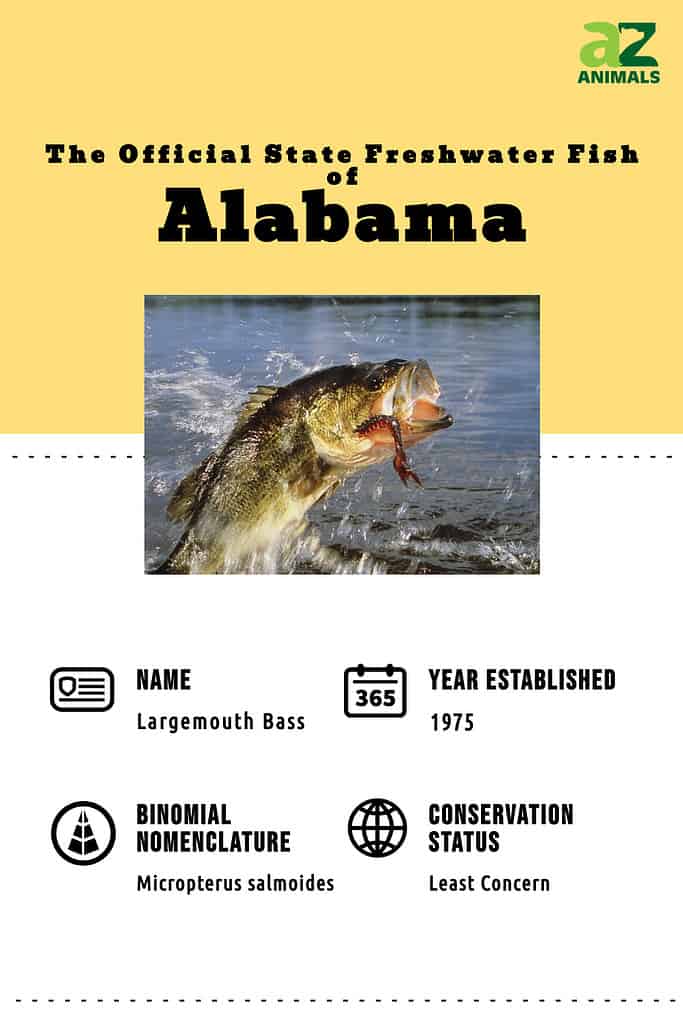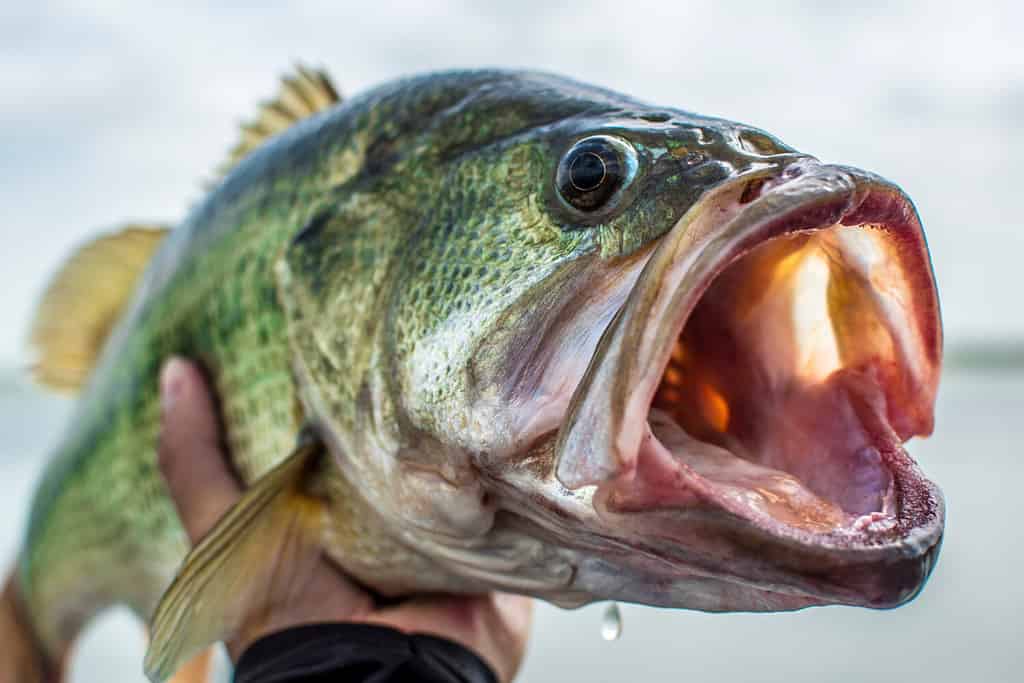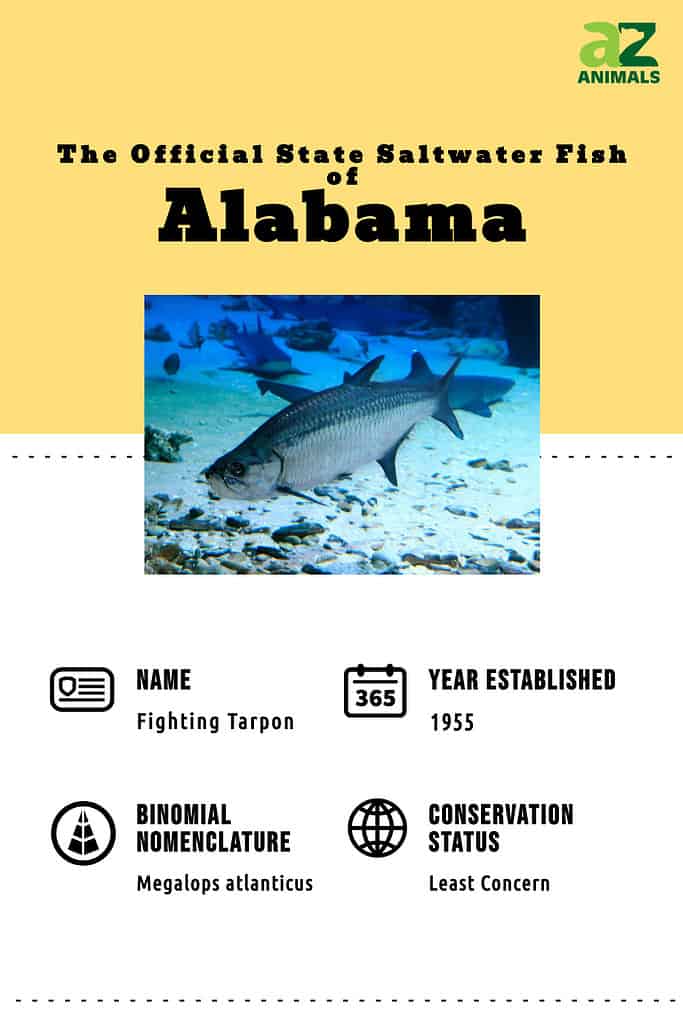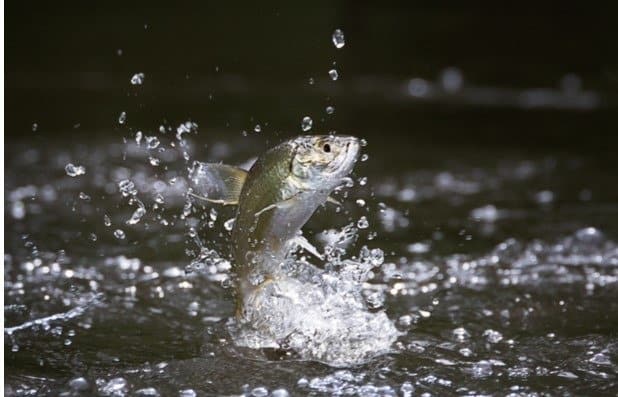Every state can choose official state animals, including mammals and aquatic fish. The official state fish of Alabama are the largemouth bass and the tarpon. Largemouth bass is one of those species found in abundance across the United States, but tarpon is less common.
While most states only have one state fish, Alabama has one for fresh water and salt water. Fresh water is any body of water that contains less than .05% salt, while saltwater must contain more than 3% salt. Due to Alabama being next to The Gulf of Mexico, it also provides anglers the chance to catch some saltwater fish.
That being said, if you’re interested in learning about Alabama’s state fishes, you’re in luck! Below, we’ll give you a detailed breakdown of the two species and where to find them this summer.
The Official Freshwater Fish of Alabama

The official freshwater fish of Alabama is the largemouth bass. In the United States, the largemouth bass is one of the most abundant and popular fishes for angling. It was introduced to rivers and streams more than a hundred years ago and has since become a staple in most rivers across North America.

The largemouth bass is the freshwater state fish of Alabama
©Pierre Rebollar/Shutterstock.com
The largemouth bass can be found all over North America, including Canada, Mexico, and the United States. They are notoriously known as game fish, as they are abundant across the country. In addition, anglers find the fish’s aggressive nature exciting to catch.
Appearance
Largemouth bass can be distinguished by its unique green to olive-colored scales. One distinctive marking is a horizontal black stripe running along each side of the fish. Their underbelly is often light and can be white or pale yellow.
Its body is also elongated with a broad head and an extremely large mouth. When its mouth is closed, the jaw extends behind the eye. In addition, they have two dorsal fins, one spiny and the other soft. Their tail is also forked with a longer anterior fin.
Size
The largemouth bass isn’t a small fish but comes in varying sizes. The average largemouth bass ranges from 12 to 24 inches in total body length. There have also been records of largemouth bass becoming over 24 inches and weighing up to 20 pounds.
Generally, the males are the bigger for most species. However, female largemouth bass are bigger than their male counterparts. The males average seven pounds or less, while females can span 24 inches and weigh over 20 pounds.
Environment
The fish can be found in many environments, including freshwater and brackish habitats. They tend to be attracted to slow-moving streams where they can find an abundant food source. For example, they can be found in streams, rivers, lakes, etc.
As long as the water has a soft bottom and is clear, they will be attracted to it. However, it’s also not uncommon to find them in reservoirs where they’ve been introduced to help control fish populations.
Diet
It will have a varied diet depending on where the largemouth bass lives. Typically, largemouth bass are carnivores and tend to eat other aquatic life. This may include other fish, frogs, birds, and turtles. If they aren’t finding prey to feed on, they have also been known to consume insects and other invertebrates.
Where Can You Find Largemouth Bass in Alabama?

Largemouth bass can be found in Lake Guntersville.
©Carl Banks Photography/Shutterstock.com
Largemouth bass can be found everywhere throughout the state. They are an invasive species and roam most freshwater lakes, streams, and ponds.
If you’re looking for sporting fish, you will want to look for recreational fishing spots. In general, the more popular the spot, the larger the largemouth bass.
Here are five of the best places to find largemouth bass in Alabama:
- Lake Guntersville
- Pickwick Lake
- Coosa River Chain of Lakes
- Lake Eufaula
- Lewis Smith Lake
Largemouth Bass Fishing Regulations
In the state of Alabama, the best time to catch largemouth bass is during the spring season. From May until July, you can catch largemouth bass when they are actively hunting for food. The species love eating minnows, crayfish, and other types of bait which can be used to your advantage.
The state allows anglers to catch largemouth bass between 13-16 inches long, depending on where you’re fishing. You’ll need to check the specific fishing area you plan to fish at, as they might have different regulations.
For example, Guntersville Reservoir allows largemouth bass as long as they are longer than 15 inches. On the other hand, Walter F. George only allows them if they are 14 inches or more. So, staying in the know about what regulations are in each designated fishing area is key.
The Official Saltwater Fish of Alabama

The official saltwater fish of Alabama is the fighting tarpon, also known as the silver king. Since Alabama has coastal borders, the tarpon can be found on the coast, estuaries, lagoons, and some rivers throughout the state. The species is known for its aerobatics and large size.
Appearance

The saltwater fish of Alabama is the fighting tarpon.
©sljones/Shutterstock.com
The species has distinctive greenish scales with blue on top and silver on the sides. Their coloration is designed to help them blend in with the environment, helping them survive. When in the ocean, their scales almost become reflective and make them look like they dazzle in the sunshine.
They have an elongated body that tapers at the end. Their dorsal fin is another distinguishable feature, as it extends far from their body and has a forked design. Another distinctive trait is their upward-facing mouth and protruding jaw. Their jaw can eat a variety of prey, especially other fish and crustaceans.
Size
Amongst saltwater and freshwater fish, the tarpon is one of the largest. They have been known to get as big as eight feet in length and weigh over 200 pounds. Typically, males stay around 100 pounds or less. Females, on the other hand, get over 200 pounds and can even become over 300.
Environment
Tarpons are saltwater fish and often can be found in coastal waters. They also inhabit brackish water, a mix of salt and fresh water. Commonly, you can find them both nearshore and offshore depending on their food supply. They enjoy swimming deep into the ocean’s depths, inhabiting reefs.
Aside from that, you can find them in freshwater systems. While more uncommon, they can be found in freshwater rivers, deltas, and lakes. They often can be found in low areas of rivers and estuaries. Tarpons are very adaptable and, due to this, can be found in a wide range of environments.
Diet
The tarpon is a predator and will always eat any other living species they can get. Often, they will go after other fish that are small to medium in size. They consume crustaceans such as shrimp and crab if they can’t find fish. If living in a freshwater environment, they often eat insects such as ants and beetles.
Where Can You Find Tarpon in Alabama?

Tarpons tend to live in saltwater environments.
©George Dodd III/Shutterstock.com
Tarpons are mainly saltwater fish and only can be found in coastal areas, such as the southern tip of the state. This area attaches to the Gulf of Mexico, which hosts a wide range of saltwater aquatic sea life you won’t see anywhere else in the state. The most common area to find tarpons is around Mobile Bay.
If you’re interested in angling one of these fish, you can catch them at designated fishing spots. Many tend to be around Perdido Pass, but many designated areas exist. It mostly depends on the time of year, as Tarpon will move around to where other prey is.
Here are some of the best places you find Tarpon fish:
- Perdido Pass
- Orange Beach
- Mobile Bay
- Dauphin Island
Tarpon Fishing Regulations
You must get a fishing license, such as a Tarpon Tag, to fish. There are also strict limitations for fishing, including any Tarpon smaller than 60 inches in total length. Tarpons caught must be killed or harvested.
In addition, within five days of catching one, you must complete and submit a questionnaire for the tarpon tag to the Department of Conservation and Natural Resources, Marine Resources Division.
The photo featured at the top of this post is © George Dodd III/Shutterstock.com
Thank you for reading! Have some feedback for us? Contact the AZ Animals editorial team.







